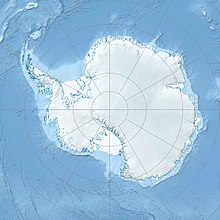Mawson Station
Coordinates: 67 ° 35 ′ 59 ″ S , 62 ° 52 ′ 59 ″ E
The Mawson Station is one of the Australian government agency Australian Antarctic Division operates all year round (AAD) research station in Antarctica . It was built in 1954 at the suggestion of Phillip Law , then director of the agency, as Australia's first base on the Antarctic continent and was the first permanent station south of the Arctic Circle . It was named after the Australian polar explorer Sir Douglas Mawson , who led the first Australian Antarctic expedition from 1911 to 1914. With the construction, Australia renewed its territorial claims on the continent.
location
The station is located on an isolated rocky outcrop on the coast of Mac Robertson Land on the eastern edge of the Antarctic Plateau. The location on Holme Bay was chosen primarily because of the ice-free access in summer. The buildings of the research station are on the sloping land behind the docking facilities, the so-called Horseshoe Harbor .
history
The expeditions of Sir Douglas Mawson
The coast and mountains of Mac Robertson Land were discovered by Douglas Mawson from his ship RRS Discovery during the British Australian and New Zealand Antarctic Research Expedition (BANZARE), which ran from 1929 to 1931 . He named the area after the industrialist Macpherson Robertson (1859-1945), who had given the expedition sustainable financial support. Mawson took possession of the land for the British Crown. At the same time, Norwegian whalers also opened up the area on behalf of magnate Lars Christensen , as evidenced by several geographical names today. The second part of his expedition took Mawson back to the coast of Mac Robertson Land in early 1931, and on February 18, 1931 he was the first person to land in this part of East Antarctica at Cape Bruce.
New forays on the continent
After the end of World War II , the Australian government revived the tradition of geographic and hydrographic research from Mawson's expeditions, and the Australian Department of External Affairs organized three polar expeditions under the direction of the newly created Australian National Antarctic Research Expeditions (ANARE). The aim of the company was to set up two research stations on the islands of Heard and Macquarie and to search for a suitable location on the George V coast to set up a permanent station on the Antarctic continent. In addition to the scientific aspect, the construction of the stations was also intended to reinforce Australia's territorial claim.
In the summer of 1947/48 the first two stations on Heard and Macquarie were put into operation. The plan to open up the Antarctic mainland from there, however, had to be abandoned after the research vessel HMAS Wyatt Earp had proven unsuitable for a journey through the pack ice . In the years that followed, the effort required to operate the two existing stations reduced the Antarctic Division's efforts to move to the continent.
The construction of the station
It was not until 1953 that Phillip Law, the then director of the Australian Antarctic Division, took up the idea again. Using aerial photographs of the US polar expedition, Operation Highjump, from the summer of 1946/47 and Norwegian maps, he identified Horseshoe Harbor in Mac Robertson Land as the best location for a year-round research station. The decisive factors were the location to the northern lights zone and the proximity to the existing supply routes for the station on Heard. After Law had received the approval for a small expedition, he went on February 4, 1954 in Melbourne on board the Danish icebreaker Kista Dan and set off for Antarctica. After a stopover on Heard Island, the ship reached the chosen spot on February 13, 1954. Law hoisted the Australian flag on the rocky coast and named the site Mawson Station in honor of the most important Australian arctic explorer Sir Douglas Mawson . When the expedition started again ten days later, three barracks had been built. A group of ten, led by Robert Dovers , stayed behind to hibernate at the station and build the core of the base. Two more buildings were added by the end of the year.
Competing ownership claims from Great Britain, Chile and Argentina put the Antarctic Peninsula at the center of the polar activities of these countries. The Mawson Station - until 1957 the only base in this part of East Antarctica - developed into the starting point for exploring the coast east of the Amery Ice Shelf and the West Enderbyland , as well as for developing the Antarctic hinterland. The construction of an aircraft hangar, the first on the continent, in 1956 made it possible to explore the Lambert Glacier and the Prince Charles Mountains from the air. By the end of 1957, 26 buildings had been erected, nine years later there were more than 50.
Technical Equipment
In 2003, two wind turbines from the German manufacturer Enercon were installed at the Mawson station in order to significantly reduce the diesel consumption for powering the research facility. The two Enercon E-30 wind turbines each have a nominal output of 300 kW and a rotor diameter of 30 m and are maintained by the staff at the research station themselves.
Web links
- Homepage of the Australian Antarctic Division
- Mawson Station web camera with weather information
- COMNAP Antarctic Facilities ( Memento of November 3, 2011 in the Internet Archive ) (English)
- COMNAP Antarctic Facilities Map ( Memento from September 15, 2009 in the Internet Archive ) (English)

